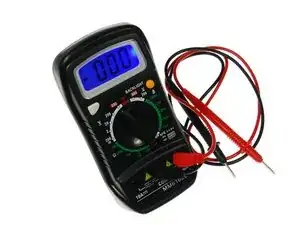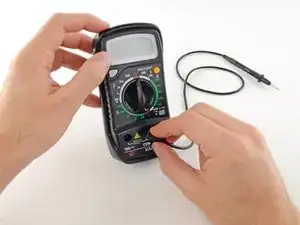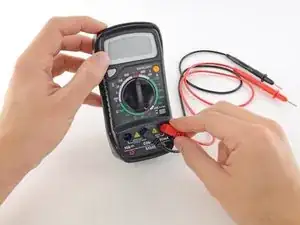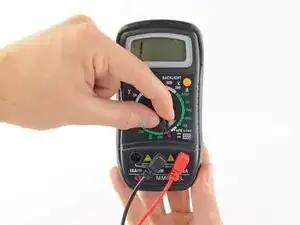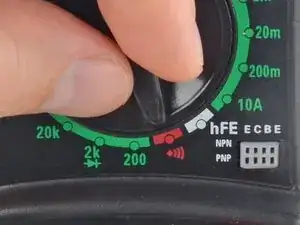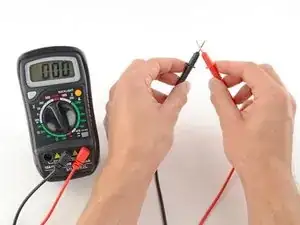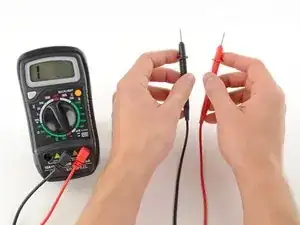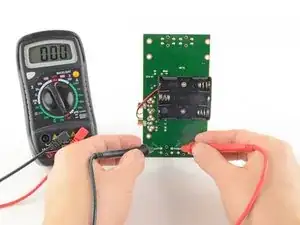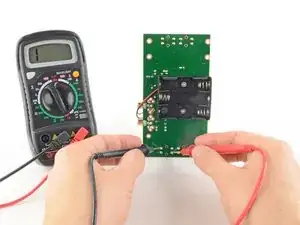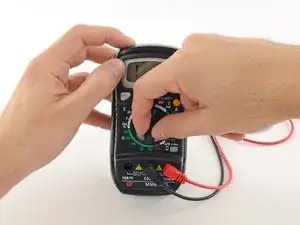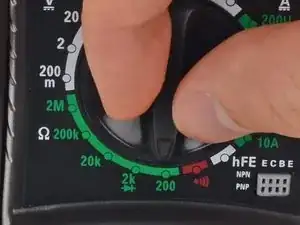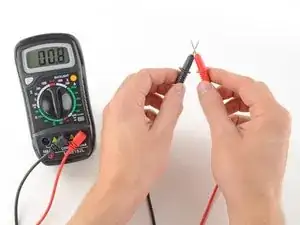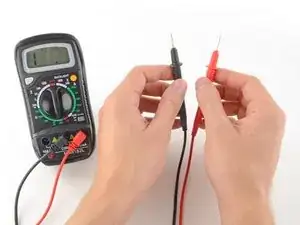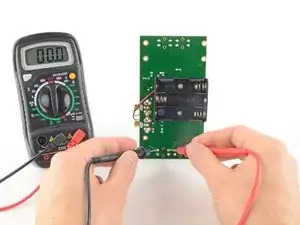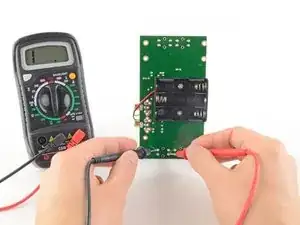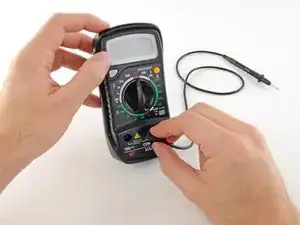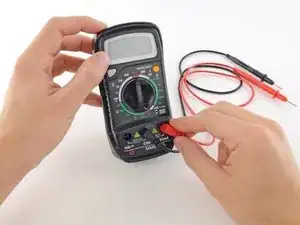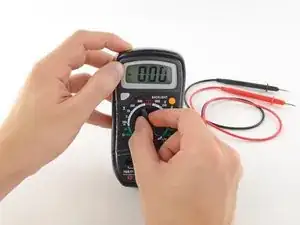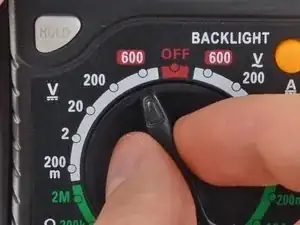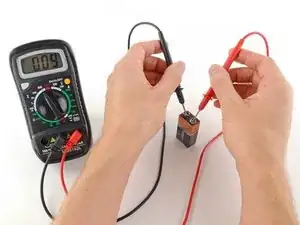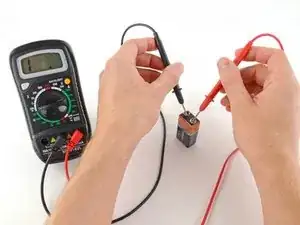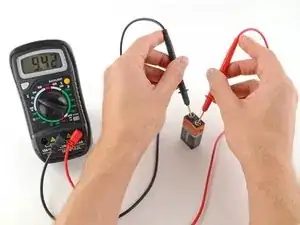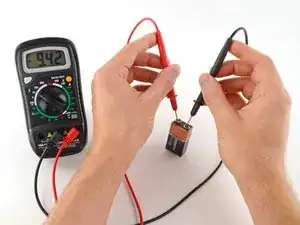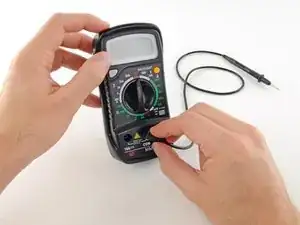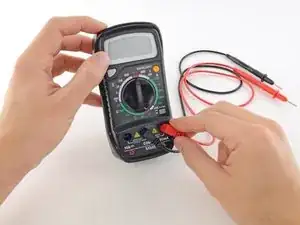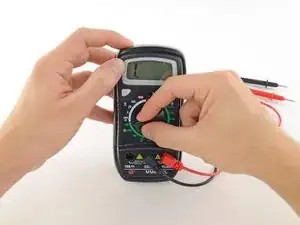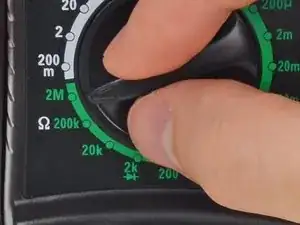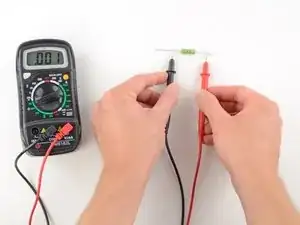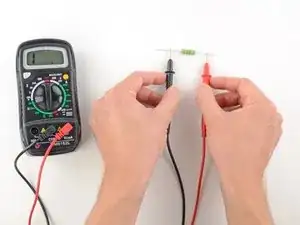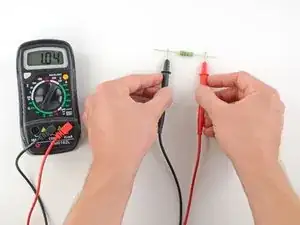Einleitung
Jeder Heimwerker sollte mit einem Vielfachmessgerät auskennen, mit dem man ungefähr tausend verschiedene Sachen messen kann. Lerne hier die drei Basisfunktionen eines Vielfachmessgerätes.
Teil 1: Überprüfe den Stromfluss
Werkzeuge
-
-
Anhand einer Stromüberprüfung wird festgestellt, ob zwei Dinge elektrisch miteinander verbunden sind, d.h. ob ein elektrischer Strom ungehindert fließen kann.
-
Wenn kein Stromfluss vorhanden ist, bedeutet das, dass der Kreislauf irgendwo unterbrochen ist. Dies kann auf eine durchgebrannte Sicherung oder eine schlechte Lötverbindung hinweisen.
-
-
-
Stecke die schwarze Messleitung in den COM Port an deinem Multimeter.
-
Stecke die rote Messleitung in den VΩmA Port ein.
-
-
-
Schalte dein Multimeter ein und stelle den Drehschalter auf die Einstellung für den Stromdurchgang (zu erkennen an einem Zeichen, das wie eine Schallwelle aussieht).
-
-
-
Das Multimeter testet den Stromdurchgang, indem es kleine Strommengen durch eine Messleitung schickt und überprüft, ob die andere Messleitung sie empfängt.
-
Wenn die Messleitungen miteinander verbunden sind - entweder durch einen geschlossenen Kreislauf, oder durch direkte Berührung - fließt der Teststtom hindurch. Das Display zeigt den Wert 0 (oder einen Wert nahe 0) an und das Multimeter piepst. Der Strom fließt!
-
Wenn kein Teststrom erkannt wird, heißt das, dass kein Strom fließt. Das Display zeigt 1 or OL (open loop) an.
-
-
-
Um deinen Stromdurchgangstest durchzuführen lege die Messleitungen an den Enden der Schaltung oder der Komponente an, die du testen möchtest.
-
Gleiches Phänomen wie vorher, wenn ein Strom fließt, wird 0 anzeigt und ein Piepsen ertönt.
-
Wenn 1 oder OL (open loop) gezeigt wird, ist kein Stromdurchgang vorhanden – das heißt, der Stromfluss von einer Messleitung zur anderen ist unterbrochen.
-
-
-
Wenn dein Vielfachmessgerät keinen speziellen Modus für den Stromdurchlauftest hat, kannst du trotzden einen Durchlauftest durchführen.
-
Stelle dafür den Drehschalter auf die kleinste Einstellung im Widerstandsmodus.
-
-
-
In dieser Einstellung sendet das Multimeter kleine Strommengen durch eine Messleitung und misst, ob und was durch die andere Messleitung empfangen wird.
-
Wenn die Messleitungen verbunden sind - entweder durch einen Stromdurchlauf oder durch direkte Berührung, fließt der Teststrom hindurch. Das Display zeigt einen Wert von 0 (oder nahe 0, in diesem Fall 0,8). Ein sehr geringer Widerstand sagt aus, dass ein Stromdurchlauf stattfindet.
-
Wenn kein Strom festgestellt wird, heißt es, dass kein Durchlauf stattfindet. Das Display zeigt 1 an.
-
-
-
Um die Durchgangsprüfung zu vervollständigen, platziere je eine der Messleitungen an jedem Ende der Schaltung oder der Komponente, die du testen möchtest.
-
Gleiches Phänomen wie vorher, wenn ein Strom fließt, wird 0 anzeigt.
-
Wenn 1 angezeigt wird, ist kein Stromdurchgang vorhanden - das heißt, es gibt keinen Weg für elektrischen Strom von einer Messleitung zur anderen.
-
-
-
Schließe die schwarze Messleitung am COM Port des Multimeters an.
-
Schließe die rote Messleitung am VΩmA Port an.
-
-
-
Schalte dein Vielfachmessgerät ein und stelle den Drehschalte auf den DC Spannungsmodus (erkennbar durch ein V mit einem gerade Strich oder dem Symbol⎓).
-
Die meisten Vielfachmessgeräte stellen sich nicht automatisch auf eine Spannung ein, was heißt, dass du einen ungefähren Bereich für die Spannung einstellen musst, die du erwartest.
-
Jede Einstellung auf der Skala zeigt die Maximalspannung an, die gemessen werden kann. Wenn du zum Beispiel erwartest mehr als 2 Volt, aber weniger als 20 zu messen, verwende die 20 Volt-Einstellung.
-
Wenn du dir nicht sicher bist, starte mit der höchsten Einstellung.
-
-
-
Platziere die rote Messleitung am Pluspol, die schwarze Messleitung am Minuspol.
-
Wenn der eingestellte Bereich zu hoch eingestellt war, kriegst du möglicherweise keine sehr genauen Angaben. Hier zeigt das Gerät 9 Volt an. Das ist bereits aussagekräftig, aber wir können noch einen kleineren Bereich einstellen, um eine noch genauere Zahl zu bekommen.
-
Wenn du den Bereich zu klein einstellst, zeigt das Multimeter einfach 1 oder OL an, was bedeutet, dass der Wert außerhalb des Bereiches liegt. Das schadet dem Multimeter nicht - in dem Fall wird einfach ein größerer Bereich eingestellt.
-
-
-
Mit einem korrekt eingestellten Bereich, erhalten wir einen Wert von 9,42 Volt.
-
Vertauschte Messleitungen richten keinen Schaden an - in dem Fall erhälst du einen negativen Wert.
-
-
-
Stelle zu Beginn sicher, dass kein Strom durch den Kreislauf oder die Komponente fließt, die du überprüfen möchtest. Schalte etwa Geräte aus, stecke es aus und entferne sämtliche Akkus.
-
Schließe die schwarze Messleitung am COM Port des Multimeters an.
-
Schließe die rote Messleitung am VΩmA Port an.
-
-
-
Schalte das Multimeter an und stelle den Drehschalter auf den Widerstandsmodus.
-
Die meisten Vielfachmessgeräte stellen sich nicht automatisch auf eine Spannung ein, was heißt, dass du einen ungefähren Bereich für die Spannung einstellen musst, die du erwartest.
-
-
-
Platziere eine Messleitung auf jeder Seite der Komponente, die du überprüfen möchtest.
-
Wenn dein Multimeter einen Wert nahe Null anzeigt, ist der Bereich zu groß für eine gute Messung eingestellt. Stelle den Drehschalter auf eine kleinere Einstellung ein.
-
Wenn du den Bereich zu klein einstellst, zeigt das Multimeter einfach 1 oder OL an, was bedeutet, dass der Wert außerhalb des Bereiches liegt. Das schadet dem Multimeter nicht - in dem Fall wird einfach ein größerer Bereich eingestellt.
-
Eine andere Möglichkeit ist, dass der Stromkreis oder die Komponente keinen Stromdurchgang erfährt - d.h. der Widerstand ist unendlich. Wenn ein nicht durchgehender Stromkreis vorliegt, wird das Ergebnis eines Widerstandstests immer 1 oder OL sein.
-
